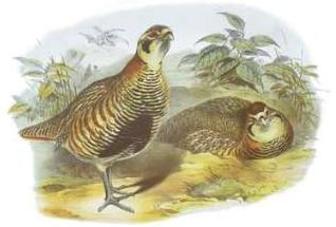Tibetan Partridge
This partridge breeds on the Tibetan plateau in Tibet itself, Northern Pakistan via Kashmir onto northwestern Indian, northern parts of Nepal, Sikkim and Bhutan, and western China.

The Tibetan Partridge is classified as Least Concern. Does not qualify for a more at risk category. Widespread and abundant taxa are included in this category.
Tibetan Partridge has a striking black and white face pattern, black breast barring and 16 tail feathers instead of the 18 of the other species. None of the species is threatened on a global scale, but the two more widespread partridges are over-hunted in parts of their range. The Grey Partridge has been badly affected by agricultural changes, and its range has contracted considerably. More
The Tibetan Partridge Perdix hodgsoniae is a gamebird in the pheasant family Phasianidae of the order Galliformes, gallinaceous birds. This partridge breeds on the Tibetan plateau in Tibet itself, Northern Pakistan via Kashmir onto northwestern Indian, northern parts of Nepal, Sikkim and Bhutan, and western China. It is found on mountain slopes and high meadows with some Rhododendron bushes, dwarf Juniper or other scrubs for cover, typically between 3,600 - 4,250 m (11,800 – 14,000 ft). More
Tibetan Partridge is not globally threatened, and seems secure in its extensive and often inaccessible range on the Tibetan plateau. The scientific name commemorates English civil servant, ethnologist and naturalist Brian Houghton Hodgson. Copyright: Wikipedia. This article is licensed under the GNU Free Documentation License. It uses material from Wikipedia. More
Tibetan Partridge is found in the following countries: 1. Bhutan 2. China 3. India 4. Nepal Site Developed & Maintained by Shah Jahan & Sajna A Iqbal Design By FSquares COPYRIGHT (C) TheBirdsISaw.COM. ALL RIGHTS RESERVED. 2007. More
The Tibetan Partridge Perdix hodgsoniae is a gamebird in the pheasant family Phasianidae of the order Galliformes, gallinaceous birds. More

Family : Phasianidae
Genus : Perdix
Species : hodgsoniae
Authority : (Hodgson, 1857)

